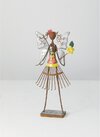"Abrasive wear generally causes damage in a single action. The hard particles of one surface or particles which are entrapped between two surfaces cause a permanent change in the physical dimensions of the other surface on their first pass over it. The most important factors which govern abrasive wear are the number of hard protruding particles present, their shape, and their hardness. The wear which occurs can be deformation with no material loss or it can cause particle formation (material removal). Which of these occurs depends on the material properties of the abrading particles (either loose third-body particles or asperities on the opposing surface) as well as material properties of the abraded material.
Sometimes when a material is only deformed and no material is lost (no weight change), the wear mechanism is termed plowing. Continued plowing, however, can eventually lead to wear debris. Rigney and Glaeser state that the repeated plowing of asperity contacts over a ductile mating surface can produce high dislocation densities. This brings about an eventual change in the microstructure which assumes a cellular pattern characteristic of heavily deformed metals. This structure presents many favorable sites for subsurface cracking and the eventual release of thin wear flakes [21].
Cutting or scratching has been used to describe when material is removed in an abrasive manner. The wear scars are different for the plowing and cutting modes of abrasive wear. Mulhearn and Samuels have shown that the angle which an abrading particle makes with an opposing surface can determine whether plowing or cutting occurs.
This "critical rake angle" often determines the transition between cutting and plowing [22]. Most of the abrasive wear models include geometric asperity descriptions, so that wear rates turn out to be very dependent on the shape and apex angles of the abrasive particles moving along the surface. If a significant portion of contact events is of cutting type, abrasion is a form of wear which is relatively efficient [22]. Cutting type behavior depends on the mechanical properties, especially hardness, of the surface which is being worn since cutting requires indentation. The wear debris generated from cutting and plowing type events can differ considerably.
Any wear situation can be thought of as being part of a spectrum with (micro)cutting at the left side (most effective) and less efficient wear mechanisms such as smooth sliding towards the right. In this representation, the overall abrasion processes are intermediate, with the most efficient ones towards the left (mostly cutting) and others further right (less cutting, smoother sliding) [23]. Abrasion is most effective when microcutting dominates.
Microcutting occurs when hardness differences are sufficient and when local rake angles are appropriate. The debris particles generated are usually cutting chips with a composition basically identical to that of the abraded material [24]. Where a given situation falls depends on the factors mentioned in this section. Lubrication may have little effect on abrasive wear and in certain cases adding a lubricant may actually increase the wear rate [25]."
For the best sound and least wear find the fine line between the cutting and plowing wear mechanisms.




